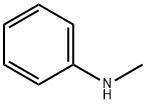100-61-8

Product Name:
N-Methylaniline
Formula:
C7H9N
Synonyms:
Monomethylaniline;N-Methylaniline
Inquiry
CHEMICAL AND PHYSICAL PROPERTIES
| Physical Description | N-methylaniline appears as a colorless to brown viscous liquid. Insoluble in water and denser than water. Contact may irritate skin, eyes and mucous membranes. May be toxic by ingestion. Used to make other chemicals. |
|---|---|
| Color/Form | COLORLESS OR SLIGHTLY YELLOW LIQ |
| Odor | Weak, ammonia-like odor. |
| Boiling Point | 385.3 °F at 760 mmHg (NTP, 1992) |
| Melting Point | -71 °F (NTP, 1992) |
| Flash Point | 175 °F (NTP, 1992) |
| Solubility | 1 to 5 mg/mL at 70.7 °F (NTP, 1992) |
| Density | 0.989 at 68 °F (USCG, 1999) - Less dense than water; will float |
| Vapor Density | 3.9 (NTP, 1992) - Heavier than air; will sink (Relative to Air) |
| Vapor Pressure | 1 mmHg at 106 °F (NTP, 1992) |
| LogP | Log kow = 1.66 |
| Stability/Shelf Life | ... TURNS REDDISH BROWN ON STANDING. |
| Decomposition | WHEN HEATED TO DECOMP, IT EMITS HIGHLY TOXIC FUMES OF /NITROGEN OXIDES/. |
| Viscosity | 2.568 cP @ 15 °C; 1.766 cP @ 30 °C |
| Heat of Combustion | -973.5 kcal/mol @ 25 °C /Liquid/ |
| Heat of Vaporization | 12.7 kcal/mol @ 25 °C |
| Surface Tension | 39.97 dynes/cm @ 15 °C; 39.54 dynes/cm @ 30 °C |
| Ionization Potential | 7.32 eV |
| Odor Threshold | Odor Threshold Low: 1.6 [mmHg] Odor Threshold High: 2.0 [mmHg] Odor threshold from AIHA |
| Refractive Index | Index of refraction: 1.57367 @ 15 °C/D; 1.5684 @ 25 °C/D |
| Dissociation Constants | pKa = 4.848 @ 25 °C |
| Kovats Retention Index | 1035 1056 1056 1040.4 1052.2 1041 1046.3 1041 1031 |
| Other Experimental Properties | Standard Heat of fusion @ 25 °C: 7.7 kcal/mol /liquid/; 20.4 kcal/mol /gas/ |
| Chemical Classes | Nitrogen Compounds -> Amines, Aromatic |
SAFETY INFORMATION
| Signal word | Danger |
|---|---|
| Pictogram(s) |
 Skull and Crossbones Acute Toxicity GHS06  Health Hazard GHS08  Environment GHS09 |
| GHS Hazard Statements |
H319:Serious eye damage/eye irritation H373:Specific target organ toxicity, repeated exposure H410:Hazardous to the aquatic environment, long-term hazard |
| Precautionary Statement Codes |
P273:Avoid release to the environment. P280:Wear protective gloves/protective clothing/eye protection/face protection. P314:Get medical advice/attention if you feel unwell. P301+P310:IF SWALLOWED: Immediately call a POISON CENTER or doctor/physician. |
COMPUTED DESCRIPTORS
| Molecular Weight | 107.15 g/mol |
|---|---|
| XLogP3 | 1.7 |
| Hydrogen Bond Donor Count | 1 |
| Hydrogen Bond Acceptor Count | 1 |
| Rotatable Bond Count | 1 |
| Exact Mass | 107.073499291 g/mol |
| Monoisotopic Mass | 107.073499291 g/mol |
| Topological Polar Surface Area | 12 Ų |
| Heavy Atom Count | 8 |
| Formal Charge | 0 |
| Complexity | 55.4 |
| Isotope Atom Count | 0 |
| Defined Atom Stereocenter Count | 0 |
| Undefined Atom Stereocenter Count | 0 |
| Defined Bond Stereocenter Count | 0 |
| Undefined Bond Stereocenter Count | 0 |
| Covalently-Bonded Unit Count | 1 |
| Compound Is Canonicalized | Yes |
PRODUCT INTRODUCTION
description
N-Methylaniline (NMA) was used in the preparation of self-assembled poly(N-methylaniline)-lignosulfonate (PNMA-LS) composite spheres with reactive silver-ion adsorbability. NMA was also used in electrodeposition of poly(N-methylaniline) (PNMA) coatings on a steel disc electrode using potentiodynamic, potentiostatic and galvanostatic techniques.
